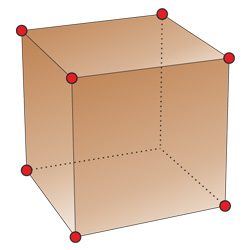

Develop spatial imagination
0.00 $
0 item(s)
What is a polyhedron? How to make pdf template
A polyhedron is a solid bounded by flat polygons, which are called faces.
Examples of polyhedra:

The sides of the faces are called edges, and their corners are called vertices.
The number of faces distinguishes polyhedra. There may be tetrahedrons, pentahedrons, etc.
A polyhedron is considered to be convex if it is located on one side of the plane of each of its faces. A polyhedron is called regular if its faces are regular polygons (i.e., where all sides and angles are equal), and all polyhedral angles at the vertices are equal. There are five types of regular polyhedra: tetrahedron, cube (regular hexahedron), octahedron, dodecahedron, icosahedron.
In three-dimensional space, a polyhedron (the concept of a polyhedron) is a set of a finite number of flat polygons where
1) Every side of a polygon is a side of the other one (but only one), called adjacent to the first one (along this side);
2) From any of the polygons that make up a polyhedron, you can reach any of them by going to the adjacent one, and from this, in turn, to the adjacent one, etc.
These polygons are called faces, their sides are called edges, and their vertices are the polyhedron's vertices.
 vertices
vertices edges
edges faces
facesA polyhedron is said to be convex if it is located on one side of the plane of each of its faces.
This definition implies that all faces of a convex polyhedron are flat polygons. The surface of a convex polyhedron consists of faces that lie on different planes. Simultaneously, the sides of polygons are the edges of the polyhedron. The polyhedron's vertices are the vertices of its faces, and the plane angles of the polyhedron are the angles of its polygons-faces.
A convex polyhedron is called a prismatoid if its vertices lie in two parallel planes. Prisms, pyramids, and truncated pyramids are particular cases of a prismatoid. All lateral faces of a prismatoid are triangles or quadrangles, while quadrangular faces are trapezoids or parallelograms.
Popular
The Italian company BULGARI, founded in 1884, actively uses the octagon's geometric shape to...
Summer is the time you want to spend outdoors. At the desk, the children will sit down in...
A polyhedronis a solid bounded by flat polygons, which are called faces....
The popular television series "Game of Thrones" is interesting not only by the complex plot, the...

